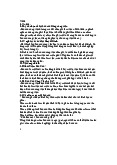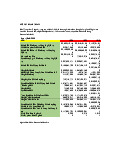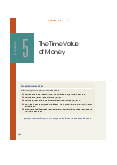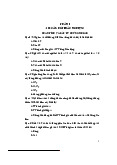







Preview text:
1. Basic objective of Financial Management is ________________. A. Maximization of profit.
B. Maximization of share holder's wealth
C. Ensuring Financial discipline in the firm. D. All of these.
2. The market value of the firm is the result of__________. A. Dividend decisions. B. Working capital decisions.
C. Capital budgeting decisions.
D. Trade-off between risk and return
3. Cost of capital is __________________. A.
Lesser than the cost of debt capital. B.
Equal to the last dividend paid to the equity shareholders. C.
Equal to the dividend expectations of equity shareholders for the coming year. D. None of the above
4. In Walter model formula D stands for _________________. A. Dividend per share B. Direct dividend. C. Direct earnings. D. None of these.
5. ___________ security is known as variable income security. A. Debentures. B. Preference shares. C. Equity shares D. None of these.
6. Quick asset does not include ____________. A. Government bonds. B. Book debts.
C. Advance for supply of raw materials. D .Inventories
7. Long term finance is required for ______________. A. Current assets. B. Fixed assets C. Intangible assets. D. None of these.
8. Risk-return trade off implies_____________.
A. Increasing the portfolio of the firm through increased production.
B. Not taking any loans which increases the risk.
C. Not granting credit to risky customers.
D. Taking decision in such a way which optimizes the balance between risk and return
9. Mr.Anil purchased 100 stocks of futura informatics ltd, for Rs.21 on March
15, sold for Rs.35 on March 14 next year. In the company paid a dividend
of Rs.2.50 per share, them Anils holding period return is______________. A.11.90%. B.45.40%. C.66.70%. D.78.60%
10. The 182-day annualized T bills rate is 9%., the return on market is 15% ,
and the beta of stock B is 1.5 the required rate of return from investment in stock B is___________. A.17%. B.18% C.19%. D.20%.
11. The risk free rate of return is 8% the expected rate of return on market
portfolio is 15% the beta of eco boards equity stock is 1.4.the required rate
on eco boards equity is__________________. A.15.4%. B.16.8%. C.17.2%. D.17.8%
12. ________ is concerned with the acquisition, financing, and management of
assets with some overall goal in mind. A. Financial management B. Profit maximization. C. Agency theory. D. Social responsibility.
13. _________ is concerned with the maximization of a firm's earnings after taxes A.
Shareholder wealth maximization. B. Profit maximization C. Stakeholder maximization. D. EPS maximization.
14. ______________ is the most appropriate goal of the firm. A.
Shareholder wealth maximization B. Profit maximization. C. Stakeholder maximization. D. EPS maximization.
15. If a company issues bonus shares the debt equity ratio ________________. A. Remain unaffected. B. Will be affected. C. Will improve. D. None of the above.
16. Treasurer should report to _______________. A. Chief Financial Officer.
B. Vice President of Operations. C. Chief Executive Officer. D. Board of Directors.
17. The __________ decision involves a determination of the total amount of
assets needed, the composition of the assets, and whether any assets
need to be reduced, eliminated, or replaced. A .Asset management. B Financing. C Investment. D. Accounting.
18. According to the text's authors, ___________ is the most important of the
three financial management decisions. A. Asset management decision. B. Financing decision. C. Investment decision. D. Accounting decision.
19. All constituencies with a stake in the fortunes of the company are known as __________. A. Shareholders. B. Stakeholders. C .Creditors. D Customers.
20. In 2 years you are to receive Rs.10, 000. If the interest rate were to
suddenly decrease, the present value of that future amount to you would __________. A. Fall. B. Rise. C. Remain unchanged. D. Cannot be determined.
21. The weighted average of possible returns, with the weights being the
probabilities of occurrence is referred to as __________.
A. A probability distribution. B. The expected return. C .The standard deviation. D Coefficient of variation.
22. ________ form of market efficiency states that current security prices fully
reflect all information, both public and private. A. Weak. B. Semi-strong. C. Strong. D. Flexible.
23. _________ is the employment of an asset is sources of fund for which the
firm has to pay a fixed cost or fixed return. A. Financial management. B. Profit maximization. C. Asset management. D. Leverage.
24. _____________ is the minimum required rate of earnings or the cut off rate of
capital expenditure. A. Cost of capital. B Working capital C. Equity capital. D. None of the above.
25. The term _________________ refers to the period in which the project will
generate the necessary cash flow to recoup the initial investment. A. Internal return. B. Payback period. C. Discounting return. D. Accounting return.
26. A mutually exclusive project can be selected as per payback period when it is _________. A. Less. B. More. C. More than 5 years. D. None of the above.
27. The project can be selected if its profitability index is more than ______. A.1%. B.3%. C.5%. D.10%.
28. X ltd issues rupees 50,000 8% debentures at a discount of 5%. The tax rate
is 50% the cost of debt capital is __________. A.4%. B.4.2%. C.4.6%. D.5%.
29. To increase the given present value, the discounted rate should be adjusted A. Upward. B. Downward. C. No change. D. Constant.
30. ________________ is one that maximizes value of business, minimizes overall
cost of capital, that is flexible, simple and futuristic, that ensures adequate
control on affairs of business by the owners and so on. A. Minimal capital structure. B. Moderate capital structure. C. Optimal capital structure. D. Deficit capital structure.
31. _____________ of different sources of capital influences capital structure. A. Restrictive covenants. B. Tax advantage. C. Cost of capital. D. Trading on equity.
32. _______________ such as restriction on business expansion, on raising
additional capital, on declaration of dividend, nominee directors on the
board, convertibility clause, etc. A. Trading on equity. B. Security of assets. C. Restrictive covenants. D. Debt capacity of a business.
33. Financial leverage refers to the rate of change in earnings per share for a
given change in earnings ___________________. A. Before tax. B. Before interest. C. Before interest and tax. D. After interest and tax.
34. Financial risk perception is an influencing factor of _____________. A. Equity structure. B. Preference structure. C. Debt structure. D. Capital structure.
35. ____________ bonds are again superior to ordinary bonds in terms of sale ability. A. Redeemable. B. Irredeemable. C. Convertible. D. Non-convertible.
36. When capital market is booming, firms can take market route to ________. A. Raise capital. B Decrease capital. C .Stop growing. D Stagnate.
37. A method of budgeting that estimates todays value of money to be
received in the future; It is discounted due to the uncertainty of its true
value in the future and for the cost of the capital is______________. A. Cash inflow. B. Cash outflow. C. Discounted cash flow. D .Payback period
38. A main benefit to the corporate form of organization is __________.
A. Double taxation of corporate income.
B. Simplicity of decision making and low organizational complexity.
C. Limited liability for the corporate shareholders.
D. A major management role exists for the firm's owners.
39. The allocation of capital is determined by _________. A. Expected rates of return. B. The Bank of Canada.
C .The initial sale of securities in the primary market.
D The size of the federal debt.
40. he mix of debt and equity in a firm is referred to as the firm's _______. A. Primary capital. B. Capital composition. C .Cost of capital. D Capital structure.
41. In finance, "working capital" means the same thing as __________. A. Total assets. B. Fixed assets. C. Current assets.
D. Current assets minus current liabilities.
42. In deciding the appropriate level of current assets for the firm,
management is confronted with _____________.
A. A trade-off between profitability and risk.
B. A trade-off between liquidity and marketability.
C. Atrade-off between equity and debt.
D. Trade-off between current assets and profitability.
43. Permanent working capital ___________.
A. Varies with seasonal needs. B. Includes fixed assets.
C. Is the amount of current assets required to meet a firm's long-term minimum needs. D. Includes accounts payable.
44. ___________ varies inversely with profitability. A. Liquidity. B. Risk. C. Accounts. D. Trade.
45. Net working capital refers to ___________. A.
total assets minus fixed assets. B.
current assets minus current liabilities. C.
current assets minus inventories. D. current assets.
46. Earlier a debt equity norm of _______ was generally insisted on by the
controller of capital issues. A.1:1. B.1:2. C.2:1. D.2:2.
47. The symptom of large inventory accumulation in anticipation of price rise in
future will be indicated by ________. A. Asset turnover ratio.
B.Working Capital turnover ratio. C. Inventory turnover ratio. D. All of the above.
48. To financial analysts, "gross working capital" means the same thing as ________. A. Fixed assets. B. Current assets. C. Working capital. D. Cost of capital.
49. An example of fixed asset is________. A. Live stock. B. Value stock. C. Income stock. D. All of the above.
50. What method of stock repurchase occurs when the buyer seeks bids within
a specified price range and accepts the lowest price that will allow it to
acquire the entire block of securities desired? A.Dutch-auction. B. Fixed-price. C. Open-market. D. Fair-warning.
51. Land at prime locations, modern buildings, machinery in good condition,
etc are accepted as __________. A. Funds. B. Security. C .Liquid cash. D Debt.
52. ___________ of debt capital is a factor in favor of using more debt capital. A.Tax advantage. B.Debt equity norms. C.Leverage effect. D.Security of assets.
53. Cost of the project is 6,00,000 , life of the project is 5 years annual cash
flow is 2,00,000 cut off rate is 10% the discounted pay back period is ______________. A.2 yrs. B.2 yrs 6 months. C.3 yrs. D.3 yrs 9 months.
54. Initial outlay 50,000, life of the asset 5 yrs, estimated annual cash flow 12,500, IRR = ____________. A.5% B.6% C.8% D.10%
55. Which of the following is the first step in capital budgeting process? A. Final approval. B. Screening the proposal. C. Implementing proposal . D.
Identification of investment proposal.
56. What is the present value of a Rs.1, 000 ordinary annuity that earns 8%
annually for an infinite number of periods? A.Rs.80. B.Rs.800. C.Rs.1, 000. D.Rs.12, 500.
57. Interest paid (earned) on both the original principal borrowed (lent) and
previous interest earned is often referred to as __________. A. Present value. B. Simple interest. C .Future value. D Compound interest.
58. Corporate governance success includes three key groups. _____________
represents these three groups.
A .Suppliers, managers, and customers.
B Board of directors, executive officers, and common shareholders.
C. Suppliers, employees, and customers.
D .Common shareholders, managers, and employees.
59. A project costs Rs, 1,00,000 annual cash flow of Rs. 20,000 for 8 years. Its
payback period is ______________. A.1 year. B.2 years. C.3 years. D.5 years.
60. Which form of market efficiency states that current security prices fully
reflect all information, both public and private? A. Weak. B. Semi-strong. C. Strong. D. Highly strong.




